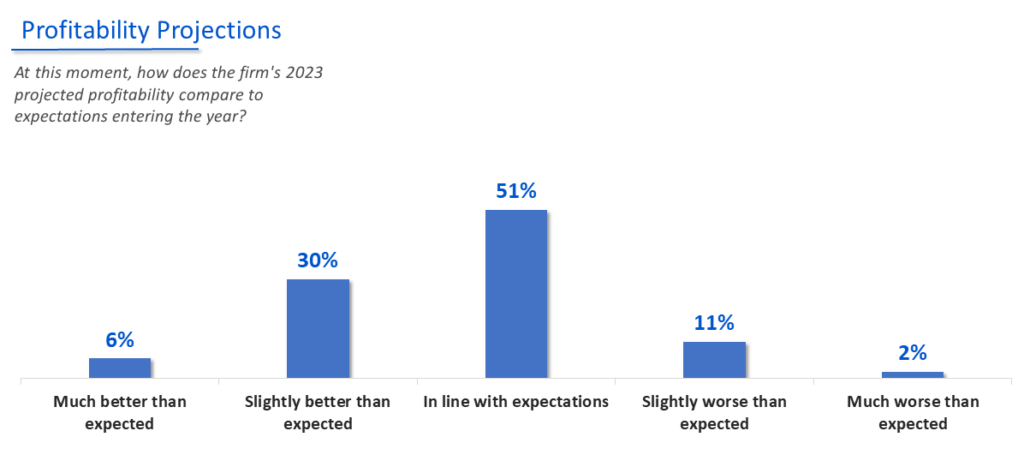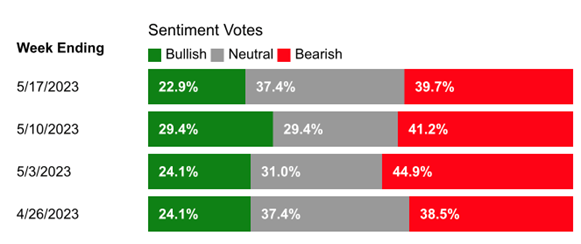Wherever the crowd goes, run in the other direction. They are always wrong.
Charles Bukowski
For many, today’s economics are confusing. Inflation is higher than Fed targets and remains sticky, but unemployment remains low, and consumer spending remains strong. Last week, HUD reported that April housing start data rose 1.6%, suggesting stabilization in home construction. In the backdrop sits the buzz and investment around generative AI.
Economists have been forecasting that a recession is looming, but those predictions repeatedly have been delayed due to positive economic surprises. And the debates around hard, soft, and no economic landings are increasingly mind-numbing.
Law firms face similar questions. Over the past year, firms have encountered significant pressures for talent and technology expenses despite decelerating demand for transactional practices, which reached artificially high peaks due to the post-pandemic spending cycle.
Our surveys and industry conversations provide a more nuanced picture. While transactional practices are slowing for some, variance is wide, and some firms are growing. For example, see Q1 transactional practice demand growth rates from the LawVision / ALM Q1 economic survey[1] below:

Yet, news cycles report dire conditions for law firms. This month, for example, Thomson published the Q1 2023 Law Firm Financial Index[2], which reported (like the past two quarters) a remarkably distressed legal industry economic score comparable to that calculated during the 2008-09 credit crisis. However, there was real fear and the possibility of economic calamity absent government intervention during the 2009 credit crunch. As a result, demand for law firms declined in double digits, and layoffs were extreme to the point of some calling those dismissed the “lost generation.”
Today’s legal economy has real pressures and risks, but they do not match 2008. In fact, our survey reported that 87% of firms are either on track or ahead of 2023 expectations on profit projections. And through Q1, demand increased for 51% of the reporting firms.

A Contrarian Perspective
Lessons can also be learned from financial markets and investor sentiment. For example, consider the AAII stock market sentiment index, a long-standing weekly survey of investors asking about their expectations for the stock market in the next six months. Interestingly, the survey is a contrarian indicator, meaning its predictive value portends the opposite of the sentiment.
As of this writing, the latest reading is 39.7% (bearish) to 22.9% (bullish), where bears exceed bulls by 17%, predicting above-average stock market returns in the next six months.

Maybe a Recession is Your Opportunity
Even if a recession were to happen this year, we could learn from terrific companies created during recessions and depressions. Some examples are listed below.
- McKinsey & Company (1930s depression) – Management consulting firm founded in 1926, just before the 1929 stock market crash and the Great Depression
- Skadden (1940s recession) – Law firm founded in 1948 during the post-World War II recession
- Jones Day (1890s recession) – Law firm founded in 1893 during the Panic of 1893
- KPMG (1980s recession) – Big Four professional services firm founded in 1987 during the late 1980s recession and the 1987 stock market crash
- LegalZoom (2000s recession) – Online legal services company founded in 2001 during the dot-com bubble burst and economic downturn
- Bloomberg (1980s recession) – Financial services and media company founded in 1981 during the early 1980s recession
- Apple Inc. (1970s stagflation) – Multinational technology company founded in 1976 during the inflation and recession of the mid-1970s
- Microsoft (1970s stagflation) – Multinational technology company founded in 1975 during the inflation and recession of the mid-1970s
- General Electric (1890s recession) – American multinational conglomerate founded in 1892 during the Panic of 1893
Your Contrarian Roadmap and Checklist
What are the lessons from this? Given the mixed economic signals above, you have a few choices: (1) lean in and make investments like the companies listed above; (2) hunker down and be defensive; or (3) operate somewhere in between. The correct answer is the one that fits your firm. Whatever your choice, consider the following contrarian checklist to help shape your thinking:
- Think Different. Now more than ever, thinking differently as a law firm is essential. And there are many opportunities for this, i.e., pricing for results rather than hours, rethinking talent mix/development/skills, accelerating service automation, productization, and creating unique client experiences.
- Create Competitive Moats. Can you identify the top one thing that truly differentiates your firm? If not, you should start building those competitive moats right away.
- Redefine Teams. Teams of the future will be different. Start designing now. Build in increasing levels of automation, plan for a varied mix of skills (i.e., legal, data, automation), and contemplate the modern legal service delivery workflow. One point frequently overlooked today is that the old ways of in-office interaction must change even as people return to the office. All lawyers and allied professionals need much better collaboration, cross-sharing, and learning opportunities than generally available pre-pandemic. Therefore, office workflows and collaboration spaces must be re-designed.
- Engage Your Clients Differently. Always put clients first but seek to differentiate in their eyes, placing you in the number one service position. And if you can’t list your client differentiators with clarity, it is imperative to work on this, or your clients will abandon you.
- Instill a Growth Mindset. Produce great results – not just excellent linear outcomes, matter-by-matter, but continually think about things you can do differently to stand out. Think exponentially while acting progressively.
- Embrace Change. Do you have an AI strategy? You need one. Create horizon-spotting teams to understand fast-moving technologies and factor them into your strategy. Then ensure your firm has enablement mechanisms to put them to work and act on these opportunities promptly.
This year may prove an inflection point for the model of law firms. And we will discuss these ideas throughout the coming months to help you explore strategies and market opportunities to be positioned to thrive in our dynamic marketplace.
*A prime example is the June 27 virtual conference Law Firm Strategy / Economics / Disruption: 2023 presented by Inside Practice, which will be a law firm economic primer and mid-year, bellwether analysis at the intersection of law firm strategy and disruption within a changing economic landscape. I will be moderating sessions as well presenting with my LawVision partners Joseph Altonji and Michael Short. Use our dedicated discount code for 25% off your registration: LVLECO25.*
We hope to see you there, but we’re also always here when you need us.
[1] To receive a copy of the full results of our Q1 ALM/LawVision survey, contact me at mmedice@lawvision.com.
[2] Formerly the Peer Monitor Index, of which I was the creator, ironically during the credit crisis of 2008-09.
Posted In


